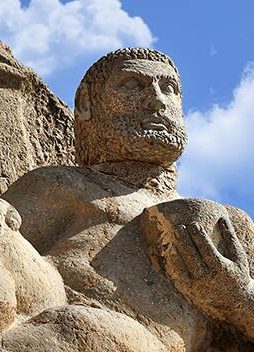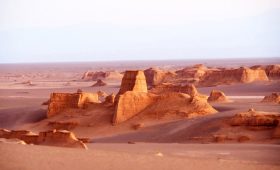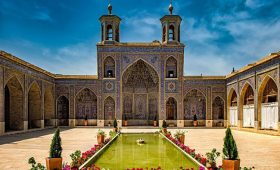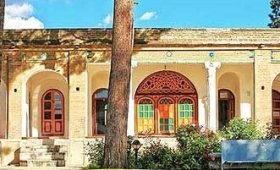The statue of Hercules near the Behistun monument of Kermanshah belongs to the Parthian and Seleucid eras and is one of the few surviving works from these historical periods. This statue was discovered during a construction operation in 1337. The statue of Hercules is considered one of the sights of Kermanshah, that attracts many tourists every year. The statue of Hercules is among the works registered in UNESCO and is in the list of national works of Iran.
Hercules statue is located east of Kermanshah in Harsin city. This statue is located under the shadow of Prav Mountain and the high peaks of this beautiful mountain such as Prav Peak and Behistun Peak. The statue of Hercules is the only one of the 28 historical monuments registered on the list of national monuments.
The construction of the statue of Hercules dates back to 153 BC. The statue of Hercules was discovered by accident in the 1330s; When Shoseh company was building Kermanshah to Hamadan road. According to the plans, this road should pass by the historical complex of Behistun. In 1335, when the workers were busy cleaning the mountain wall and leveling part of its slope to build a road.
Many have attributed the time of the construction of the statue of Hercules to 153 years before Christ, which is the same time as the middle of the reign of Mehrad I of the Parthian dynasty (9th tear, 174-136 before Christ). The statue of Hercules is the figure of a naked man with curly hair and a beard, holding a cup in his hand, lying on his side on the skin of a lion and leaning on the elbow of the other hand. This figure is placed on a platform 2.20 meters long and its length is 1.47 meters, which is formed from the cutting of mountain stones and is connected to the mountain from the back.
Behind the statue of Hercules are carved reliefs that show an olive tree. The traces of arrows and bows can be seen on the branches of this tree. Next to the tree, there is a cone-shaped mace that stands out more than the rest of the images. Beside all these motifs, you can see an inscription in Greek script written on a tablet similar to Greek temples with dimensions of 43 x 33 meters in seven lines. Under the figure of Hercules, there is also a 200 cm long and 114 cm tall lion.
Hercules fought in 12 states to achieve his previous position and to become a free man. The Roman name of Hercules is “Heracles” meaning “glory of Hera”. Herakles is one of the mythological heroes of ancient Greece and Rome, the son of the Greek gods Zeus and Alcmene. Some have attributed the statue of Hercules Behistun to this mythical and invincible figure of Greece and Rome, while others have attributed him to “Warthorghene”, the war god of ancient Iran.
The legend of Hercules in Greece is a long and turbulent legend. Zeus had sworn to give birth to an invincible and immortal child for the gods. For this he chose Alcmene, the wife of Amphitroon. By a trick, Zeus impersonated Amphitryon during the night he was in battle and slept with his wife. On the same night, Amphitryon slept with Alcmene.
Hercules was born and with the support of Athena, the goddess of wisdom and wisdom, reached the arms of Hera. Hera did not recognize him and out of pity placed him between her breasts. Hercules gained supernatural strength by drinking her milk, and shortly afterwards Athena returned him to his mother’s arms. Hercules was raised in the arms of Alcmene and Amphitryon. Amphitreon, who had learned about the powerful future of Hercules in a conversation with Tiresias the soothsayer, assigned him to various trainings such as archery, swordsmanship and wrestling under the supervision of various teachers.
In addition to training under the supervision of different teachers, Hercules received tools for battle from each of the gods; Hermes gave him a sword, Apollo gave him a bow and arrow, Hephaestus gave him a breastplate, and Athena gave him a robe. As a result, two twins were born that night, one was Hercules, the son of Zeus, and the other was Iphicles. Zeus swore that Hercules, the grandson of Perseus, would one day rule all of Greece; But his wife, Hera, with jealousy, was able to attract the companionship of Ilythea, the goddess of pregnancy, and with her help, she pushed back the pregnancy of Hercules and the birth of another descendant of Perseus, Eurosteus; In this way, Eurosteus became the king of Greece.
Hera, who was the main enemy of Hercules from the beginning of his birth, managed to make him mad with tricks. In an unbridled frenzy, he was shooting imaginary animals in his mind. Hercules had an unsuccessful attack on his nephew Iulaus; but in the end, his wife, Megara, and his three children were not freed from madness and were killed by him. After killing his wife and children, Hercules went to the seer of Apollo and asked him for guidance. The seer of Apollo introduced him to the king of the Moknai land for 12 years of his release and return.
Hercules went to that land and the king Moknai designed 12 stages of struggle for the son of Zeus to become a free man after coming out of these stages proudly. In all these stages, while benefiting from Athena’s support, Hercules did not suffer from the hatred of Hera, who was jealous of the children of Zeus from other women.
The first struggle in which Hercules’ strength was tested was his fight with a lion in the mountains of Kitharon, which had led to the destruction of Amphitreon’s herds. He killed that lion and many believe that what he is wearing is the skin of that lion. During the battle of Hercules, there was a war between Thebes and Orchemnos, in which Amphitryon was also involved. Hercules joined the war and showed a lot of bravery, due to which Athena became his ally and companion forever; But Amphitryon was killed in this war and nothing was made of him and Athena.
The struggle of Hercules consisted of 12 stages, which consisted of killing the half-lion (this lion had an impenetrable skin), killing the nine-headed hydra snake (a snake whose head is cut off, you grow two new heads in its place), capturing the deer Crenia, killing Erymantus’ wild boar, cleaning the stables of King Augeas, killing the birds of prey on the shores of Stomphalus, capturing and killing the wild bull located in Crete, capturing Diomedes’ mares, obtaining the belt of Hippolyta, queen of the Amazons, capturing the herd of Groeon (a giant warrior with three heads, three bodies and 6 arms and having a herd of cattle in red), obtaining the golden apples from the garden of the Hesperides (guarded by the 100-headed dragon Ladon), bringing Cerberus, the three-headed dog of Hades, to the surface of the earth.
The head of the Hercules statue was stolen and rediscovered by cultural thieves twice in different years, the first time in 1356 and the second time in 1372. In the robbery of 1372, the head of the statue was seriously damaged, and the authorities at that time ordered another head similar to it made of the same stone (cast iron) to be placed on the statue instead of the original head. The original head of the statue of Hercules should be preserved and kept in the cultural heritage treasure after the troubles.
The city of Kermanshah has a cold and mountainous climate and as a result very cold winters and relatively pleasant summers. On the other hand, the statue of Hercules is also located at the foot of the mountain. Therefore, to travel to Kermanshah, it is better to travel to this city from the beginning of spring to mid-autumn when relatively warmer weather prevails in this province. The best time to travel and visit the statue of Hercules is from mid-spring to the end of June; Because Kermanshah offers you the mildest weather and the most beautiful nature.




